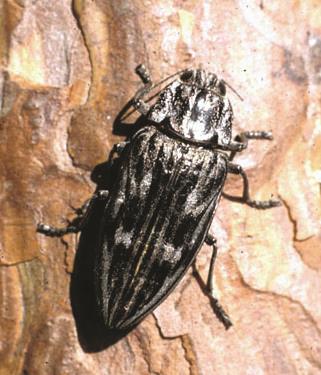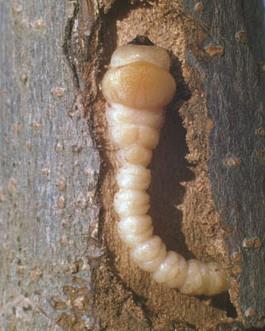Insect Gallery
Insect Details
Flatheaded Apple tree borer
Chrysobothris femorata
The adult is a broad, oval, flattened beetle about 1/4 to 1/2 inch in length. The beetle is metallic colored and marked with spots and irregular gray bands. The underside is a bronze color and the sides beneath the wings are a metallic greenish blue. The egg is pale yellow, flattened, disk-like, wrinkled, and about 1/16 inch in diameter. The larva is yellowish white, legless, and about 1 inch long when fully grown. The three thoracic segments are broadened and compressed, giving the larva the appearance of having a large flattened head. The larvae within their galleries nearly always assume the curved shaped of a horseshoe. The pupa is somewhat more yellow than the larva and resembles the adult in structure.
Adults appear from March to November, but they are most abundant during May and mid-August to mid-September. Beetles are active and take flight quickly when disturbed. On hot, clear days, they may be found on the sunny side of trunks and larger branches. The female spends much time running over the surface, probing the bark with her ovipositor for places to oviposit. Females mate and begin ovipositing in 4 to 8 days; they live about 1 month after emergence. Each female lays about 100 eggs, depositing them singly in cracks or crevices of the bark, under bark scales, and at bark injuries. Eggs hatch in 8 to 16 days. The newly hatched larva chews through the bark and feeds in the phloem and surface of the sapwood. As soon as the larva is fully developed, it tunnels from the cambium area radially into the sapwood where a pupal chamber is prepared by plugging the burrow tightly with frass; here, it overwinters as a larva. The larva pupates during the following spring or summer. The pupal stage lasts about 8 to 14 days. Adults emerge by cutting small oval emergence holes through the bark. Normally there is one generation per year.
Points of infestation can usually be detected by white, frothy sap oozing from cracks in the bark. The bark gradually assumes a darkened, wet or greasy appearance. Little or no frass is ejected except at cracks in the bark. Injured areas usually become depressions, and later the bark may split at the injured sites. Attacks occur most often on the sunny aspect of the tree. The burrows under that bark are broad and irregular and filled tightly with fine, sawdustlike frass. In young trees with thin bark, the tunnels are usually long and winding, sometimes encircling the tree. In older trees with thick bark, the burrows are confined to a circular area under the bark. Wounds may be enlarged year after year by succeeding generations. Attacks area often associated with injuries. Trunks may be attacked at any point above ground level; branches may also be attacked.

